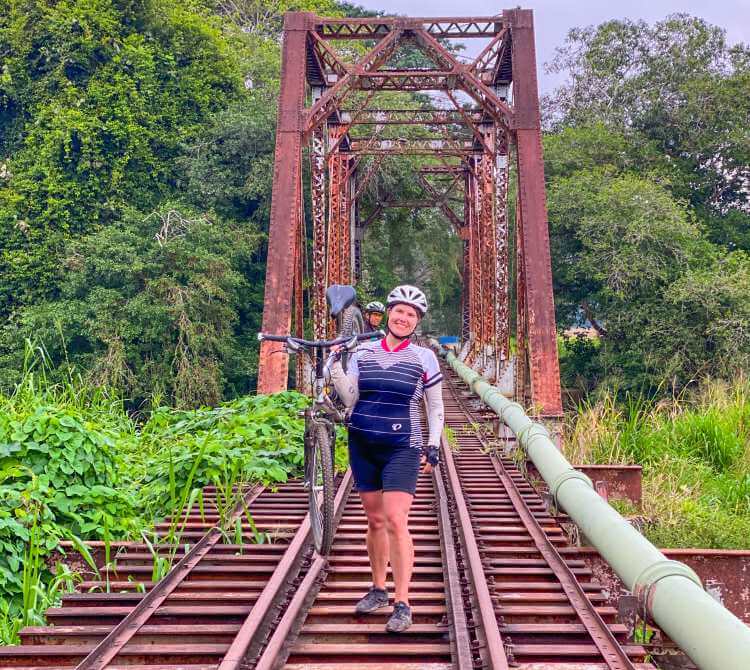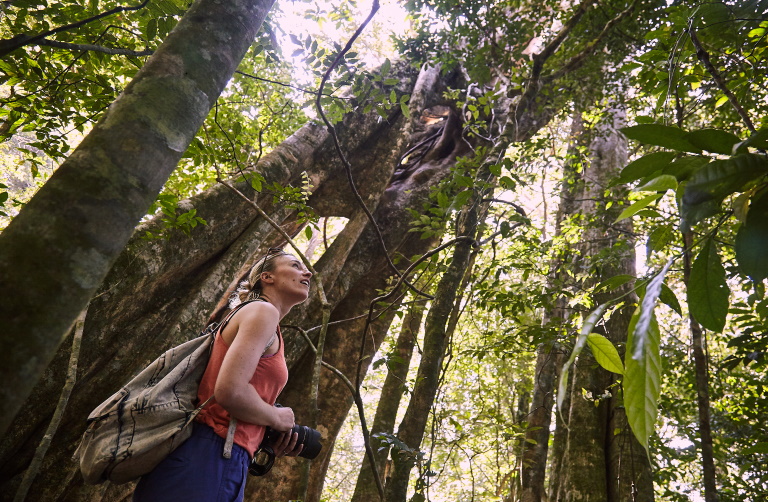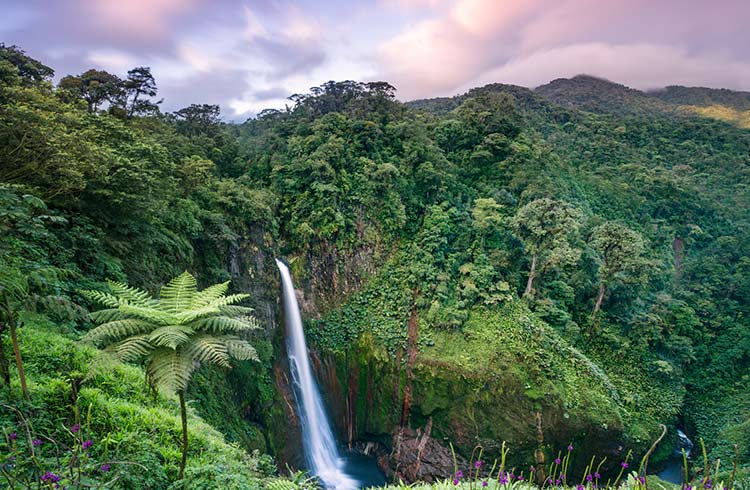6 Epic Outdoor Adventures in Costa Rica
The land of Pura Vida is known for outdoor activities – surfing, rafting, hiking, mountain biking, and ziplining are just a few of the options available. Nomad Cassandra shares her tips.
 Photo © Getty Images / Niki Harry
Photo © Getty Images / Niki Harry
Things to do in Costa Rica
With six different types of forest, dozens of volcanoes, abundant wildlife, and both Atlantic and Pacific coastlines, Costa Rica is known for outdoor activities.
Mountain biking, road cycling, rafting, paddle boarding, kayaking, zip lining, canyoneering, scuba diving, and many other activities are available all over Costa Rica. I’m including my itinerary here, but know you can find most of these options all over the country.
Zip lining and hiking in Monteverde
The Monteverde district, in the north-central part of the country, is situated in a cloud forest 4,662 ft (1,440 m) above sea level, so it’s a bit cooler and more humid than other regions. Be sure to bring a light rain jacket and waterproof hiking boots. Note that if you plan on doing any hiking in Costa Rica (even moderate hikes in the forest), you’ll want to bring actual hiking boots. Even if hiking sandals have sufficient grip for the terrain, they won’t protect you from snakes or fire ants.
In Monteverde, I visited some wildlife reserves and went on an epic zip lining and hanging bridge walk with Sky Adventures. But my highlight of the region was El Tigre Waterfalls, a collection of several falls connected by a series of hanging bridges and rugged mountain trails. Note that this is a semi-strenuous hike, but if you’re up for the challenge, you’re in for a treat – and a swim.
Waterfalls and river tubing near La Fortuna
Also in north-central Costa Rica, and located near the famous Arenal volcano, the town of La Fortuna is a popular destination that’s known for road cycling, mountain biking, zip lining. and rafting.
The La Fortuna waterfall is the most popular attraction in this region, and with good reason. I visited late on a Saturday afternoon, making my way down (and then back up) 600 steps to the 230ft (70m) waterfall, and there was only one other couple swimming with me. Half a dozen other visitors swam in the calmer stream off to the side of the waterfall.
My favorite activity in Costa Rica was river tubing with Go Adventure. I had hoped to go rafting, but since there weren’t enough people to make the tour, I joined a Costa Rican couple and floated through mild rapids and along dense forest dotted with howler monkeys and sloth. I spent both of my evenings at Paradise Hot Springs, soaking in outdoor thermal water pools that overlooked the Arenal Volcano.
Wildlife and surfing lessons at Manuel Antonio National Park
Along Costa Rica’s central Pacific coast is the jungle-meets-beach Manuel Antonio National Park. Luxury hotels surrounding the park get you closest to the beach, forest, and animals, but less-expensive accommodation can be found a 15-minute taxi ride away in the town of Quepos.
Several prominent trails and beaches are closed to prevent crowding on walkways, but I was still able to hike several miles along wooden boardwalks, where I spotted various types of monkeys, countless birds, and (with the help of my guide), venomous snakes! Bring boots, not hiking sandals.
I had hoped to go scuba diving, but a hurricane heading toward nearby Nicaragua had left the waters tumultuous and cloudy, so I took a surfing lesson instead. My instructor insisted that the “small” waves were good for beginners, but after falling about 20 times and swallowing two liters of the Pacific Ocean, I began to think he was leading me on. I did eventually stand up for about two seconds, then abandoned the activity for an afternoon nap. Should you wish to take a surfing lesson, just look for an instructor hanging around the shady area of the beach.
I've since learned that there are great surfing opportunities for beginners all over the country. The appropriateness of the waves depends mostly on the weather each day, rather than the location.

Mountain biking near San Jose
The capital city, San Jose, has the widest variety of museums, dining options, and art galleries, but if you’re looking for nature options, it’s best to just overnight here, then head elsewhere.
I joined a thrilling mountain bike tour with Marin Bike Tours that journeyed along an old, abandoned rail line outside of San Jose. Though some of the route was along paved roads that twisted and turned through spectacularly lush and beautiful scenery, much of the route consisted of riding over very muddy, rocky terrain and, in some cases, along steep drop-offs. There were also two spots where I had to walk my bicycle along very high rails that overlooked the river several hundred feet below. I enjoyed the ride, but if I were to do it again, I’d ask the guides to eliminate the most difficult parts. If you’re not experienced with mountain biking or you’re afraid of heights, I strongly suggest booking a different route.
Trip Notes
Getting around
Uber is available (and is often cheaper than taxis), as are affordable public buses that can transport you between cities. Most travelers, however, rent their own vehicle or hire a local tour operator to arrange transportation. Wi-Fi is widely available, so should you rent your own vehicle, you could download driving directions before leaving your hotel.
Costs
In general, Costa Rica is less expensive than the United States, but it’s not exactly a budget destination. Here’s a rough breakdown of major costs, but keep in mind that these figures don’t include tips (which many tourism industry workers rely on).
- Transportation: If you rent in advance, an economy car runs about USD $60 (CRC 35,400)/day; taxis cost about USD $1 (CRC 590)/kilometer; and buses cost about USD $5 (CRC 3,000) between many major cities (La Fortuna to San Jose, for example).
- Hotel: Budget hotels range from USD $30-50 (CRC 17,700-30,000)/night, mid-range are USD $80-120 (CRC 47,200-70,800), and many luxury resorts that usually run $400-600 (CRC 236,000-354,00)/night currently have discounted rates of USD $250-300 (CRC 147,500-177,000)/night.
- Food: Expect to pay anywhere from USD $15-$50 (CRC 8,900-29,500)/day on food. Meals in luxury resorts and upscale restaurants can cost much more.
Related articles
Simple and flexible travel insurance
You can buy at home or while traveling, and claim online from anywhere in the world. With 150+ adventure activities covered and 24/7 emergency assistance.
Get a quote


2 Comments
Hello! Did you have to purchase travel insurance and if so, what type? The embassy site says it is required.
Hi Rose,
Info about insurance requirements and other travel restrictions can be found here: https://www.worldnomads.com/travel-safety/central-america/costa-rica/latest-travel-alerts-and-warnings-for-costa-rica